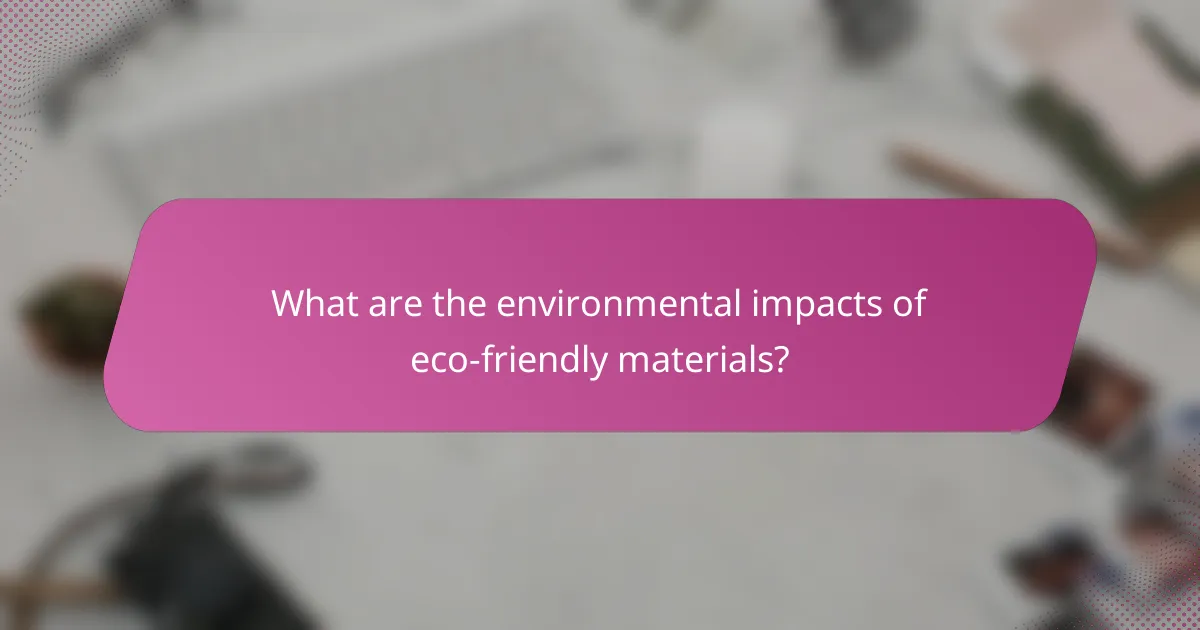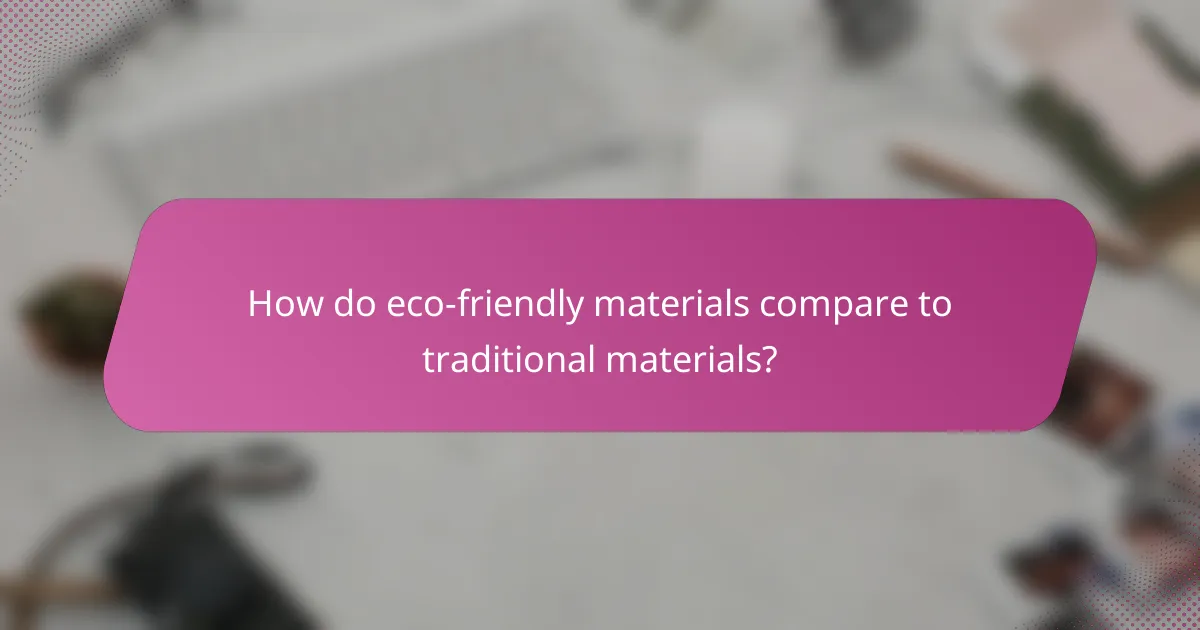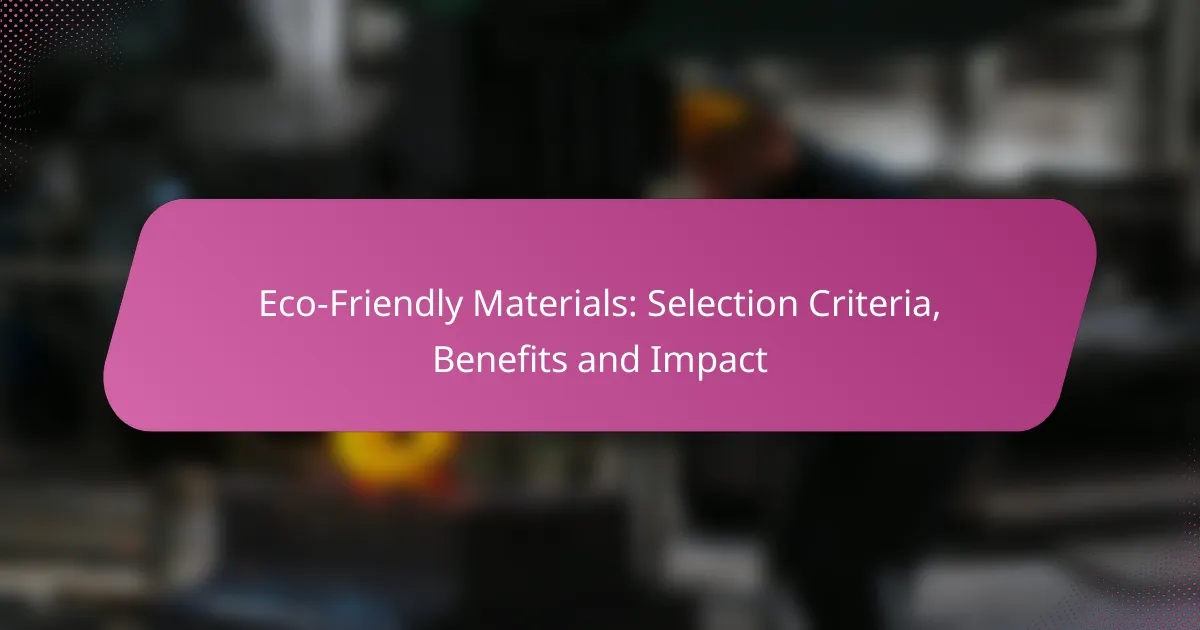Eco-friendly materials are crafted from sustainable resources designed to minimize environmental impact while promoting healthier living spaces. Choosing these materials involves assessing their lifecycle, sourcing practices, and certifications, ultimately leading to more sustainable building and manufacturing methods. By prioritizing eco-friendly options, we can significantly reduce pollution, conserve resources, and contribute to a healthier ecosystem.

What are eco-friendly materials and their benefits?
Eco-friendly materials are products made from sustainable resources that minimize environmental impact. Their benefits include reducing waste, conserving energy, and promoting healthier living environments.
Biodegradable plastics
Biodegradable plastics are designed to break down naturally in the environment, reducing pollution and landfill waste. They typically decompose within a few months to a few years, depending on conditions like temperature and moisture.
When selecting biodegradable plastics, look for certifications such as ASTM D6400 or EN 13432, which indicate compliance with industry standards. Common applications include packaging, disposable cutlery, and bags.
Recycled metals
Recycled metals, such as aluminum and steel, are repurposed from scrap materials, significantly reducing the need for new mining and processing. This process conserves energy and lowers greenhouse gas emissions by up to 95% for aluminum.
When choosing recycled metals, check for labels indicating the percentage of recycled content. This can help ensure you are supporting sustainable practices while also benefiting from the durability and strength of these materials.
Sustainable wood
Sustainable wood comes from responsibly managed forests that are certified by organizations like the Forest Stewardship Council (FSC). This ensures that the wood is harvested in a way that maintains the ecosystem and supports local communities.
When purchasing sustainable wood, consider its source and look for certifications. Common uses include furniture, flooring, and construction materials. Opting for reclaimed wood can also be a great eco-friendly choice.
Organic textiles
Organic textiles are made from fibers grown without synthetic pesticides or fertilizers, promoting healthier ecosystems and reducing chemical exposure. Common organic materials include cotton, hemp, and linen.
When selecting organic textiles, look for certifications such as GOTS (Global Organic Textile Standard) or OEKO-TEX, which ensure environmental and social responsibility. These fabrics are often used in clothing, home textiles, and upholstery.
Natural insulation materials
Natural insulation materials, such as wool, cellulose, and hemp, provide effective thermal performance while being biodegradable and non-toxic. They help reduce energy consumption in buildings by maintaining comfortable indoor temperatures.
When choosing natural insulation, consider factors like R-value (thermal resistance) and moisture control. These materials are suitable for various applications, including walls, attics, and floors, and can contribute to healthier indoor air quality.

How to select eco-friendly materials?
Selecting eco-friendly materials involves evaluating their environmental impact throughout their lifecycle, sourcing practices, and certifications. Prioritizing materials that minimize harm to the environment can lead to more sustainable building and manufacturing practices.
Assess material lifecycle
To assess the lifecycle of a material, consider its production, use, and disposal phases. Look for materials that require less energy to produce and can be recycled or composted at the end of their life. For example, bamboo is a rapidly renewable resource that can be sustainably harvested and has a lower carbon footprint compared to traditional hardwoods.
Evaluate the environmental impact of transportation as well. Locally sourced materials generally have a smaller carbon footprint due to reduced shipping distances. Aim for materials that are produced and processed close to their final destination.
Evaluate sourcing practices
Investigate the sourcing practices of the materials you are considering. Sustainable sourcing means that the materials are obtained in a way that does not deplete resources or harm ecosystems. For instance, wood should come from certified forests that follow responsible forestry practices.
Consider the social implications of sourcing as well. Materials that are sourced ethically support fair labor practices and local communities. Look for suppliers who provide transparency in their supply chain and adhere to ethical standards.
Check certifications
Certifications can provide assurance that materials meet specific environmental and safety standards. Look for labels such as FSC (Forest Stewardship Council) for wood products, or LEED (Leadership in Energy and Environmental Design) for building materials. These certifications indicate that the materials have been evaluated for sustainability.
Be aware of the variety of certifications available, as they can vary by region and material type. Research the meaning of each certification to ensure it aligns with your eco-friendly goals. Avoid materials with vague or unverified claims to ensure genuine sustainability.

What are the environmental impacts of eco-friendly materials?
Eco-friendly materials significantly reduce negative environmental impacts by minimizing pollution, conserving resources, and promoting sustainability. Their use leads to a healthier ecosystem and supports efforts to combat climate change.
Reduced carbon footprint
Using eco-friendly materials can lead to a substantially reduced carbon footprint. These materials often require less energy to produce and transport, which lowers greenhouse gas emissions. For example, products made from recycled materials typically consume less energy compared to those made from virgin resources.
When selecting materials, consider their entire lifecycle, including extraction, manufacturing, and disposal. Opt for locally sourced options to further decrease transportation emissions, which can enhance sustainability.
Less waste generation
Eco-friendly materials contribute to less waste generation by being designed for reuse, recycling, or biodegradability. For instance, biodegradable packaging breaks down naturally, reducing landfill contributions. In contrast, conventional plastics can take hundreds of years to decompose.
To minimize waste, choose products with minimal packaging or those that can be easily recycled. Implementing a waste management plan that emphasizes recycling and composting can also enhance waste reduction efforts.
Conservation of resources
Utilizing eco-friendly materials helps conserve natural resources by promoting sustainable sourcing and reducing the demand for finite resources. For example, bamboo grows rapidly and can be harvested without harming the ecosystem, making it a sustainable alternative to traditional timber.
When selecting materials, prioritize those that are renewable or made from recycled content. This not only conserves resources but also supports a circular economy where materials are reused and repurposed, minimizing the need for new raw materials.

What are the cost considerations for eco-friendly materials?
Cost considerations for eco-friendly materials involve evaluating both the initial investment and the potential long-term savings. While these materials may have a higher upfront cost, they often lead to reduced operational expenses and environmental benefits over time.
Initial investment vs. long-term savings
Eco-friendly materials typically require a higher initial investment compared to conventional options. For instance, sustainable insulation or energy-efficient windows may cost more upfront but can significantly lower energy bills over their lifespan.
When assessing long-term savings, consider factors such as durability, maintenance costs, and energy efficiency. Many eco-friendly materials have longer lifespans, which can offset their initial costs through reduced replacement and repair expenses.
Market price fluctuations
The prices of eco-friendly materials can vary due to market demand and availability. For example, fluctuations in the cost of bamboo or recycled materials can impact project budgets. Staying informed about market trends can help in making timely purchasing decisions.
It’s advisable to monitor local suppliers and compare prices regularly. Engaging with multiple vendors can provide insights into price variations and help secure better deals on eco-friendly options.
Government incentives
Many governments offer incentives for using eco-friendly materials, which can significantly reduce costs. These incentives may include tax credits, rebates, or grants aimed at promoting sustainable building practices.
Research local regulations to identify available programs. For example, in the United States, the Energy Policy Act provides tax deductions for energy-efficient improvements, while some European countries offer subsidies for sustainable construction materials.

How do eco-friendly materials compare to traditional materials?
Eco-friendly materials often offer a more sustainable alternative to traditional materials, focusing on reduced environmental impact and improved health safety. While they may vary in performance and durability, their benefits can outweigh the drawbacks in many applications.
Performance differences
Eco-friendly materials can differ significantly in performance compared to traditional options. For instance, bamboo is a popular sustainable choice that can match or exceed the strength of hardwood, while recycled plastics may not always provide the same structural integrity as virgin plastics. It’s essential to evaluate the specific application to determine if the eco-friendly option meets performance requirements.
Additionally, some eco-friendly materials, like hemp or cork, can offer unique benefits such as natural insulation properties or moisture resistance. When selecting materials, consider how these performance traits align with the intended use and environmental goals.
Durability and maintenance
Durability can be a mixed bag with eco-friendly materials. While some, like reclaimed wood, can be incredibly durable, others may require more frequent maintenance. For example, natural fibers may not withstand harsh weather as well as synthetic options, leading to higher upkeep costs over time.
Maintenance practices also vary; eco-friendly materials often benefit from non-toxic cleaning solutions and less frequent treatment with chemicals. When choosing materials, assess the long-term maintenance needs and potential costs to ensure they align with your sustainability objectives and budget.



